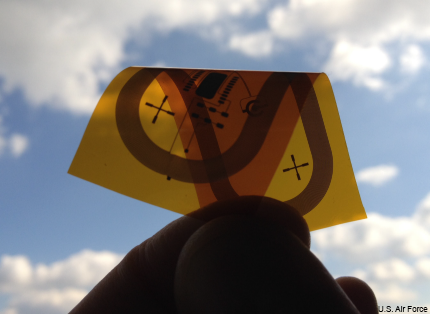AFRL, FlexTech look to revolutionize electronics
A new institute will develop flexible hybrid electronics and manufacturing processes.

The new institute help develop a new wave of lightweight, flexible electronics.
Wearable sensors, as comfortable as cotton, that can tell you your stress levels or monitor a medical condition? Antennas that conform to the shape of a helmet or radio case? Flexible prosthetics that move and feel more like the human body?
These are some of the things the Air Force Research Laboratory is ready to work on in the Flexible Hybrid Electronics Manufacturing Innovation Institute (FHE-MII) being established at Wright-Patterson Air Force Base, Ohio, according to an AFRL release. The institute, whose creation was announced in August by Defense Secretary Ashton Carter, is an outgrowth of the Defense Department’s nascent partnership with Silicon Valley tech companies and academia, intended to help foster innovation. Carter said the effort’s initial focus would be on flexible electronics.
The FHE-MII reflects the construct DOD is looking for. It involves a consortium of 162 companies, universities, and non-profits led by the FlexTech Alliance under a cooperative agreement that will be jointly managed by AFRL and the Army Research Laboratory. The institute is receiving $171 million in DOD and coalition funding for the work in developing new flexible hybrid electronics and manufacturing processes.
The initiative also is part of the broader National Network for Manufacturing Innovation, an effort launched by the Obama administration in 2012 to spur advances in manufacturing (mostly additive, or 3D, manufacturing) and bring processes and products to market more quickly. FHE-MII is one of seven manufacturing institutes that have been set up so far under the program.
Flexible hybrid electronics is one of the next technology frontiers. Through 3D printing or other additive processes, FHE can result of lightweight, stretchable, pliant electronics that can be used as everything from light energy storage devices to medical diagnostic and monitoring devices. The general goal is to make all kinds of electronics lighter, more flexible and capable of being quickly produced and tested.
In a separate project, in fact, AFRL just awarded a $45 million contract for research into incorporating biotechnology into flexible electronics for energy storage.
The consortium government/industry/academia structure should increase the opportunities for collaboration and information sharing, AFRL said. Air Force researchers, for example, will have access to the FHE Prototyping and Testing facility, located in San Jose, Calif., which will help turn AFRL’s own proof-of-concept demonstrations into affordable, reliable products.
"AFRL is very excited about what the institute will mean for the future of flexible hybrid electronics technology," said Dr. Benjamin Leever, AFRL lead for Functional Additive Manufacturing Materials. "The capabilities that will emerge from this agreement will lead to increased awareness and revolutionary breakthroughs that will benefit the warfighter in ways previously unimaginable."
NEXT STORY: Is China building its first homegrown carrier?



